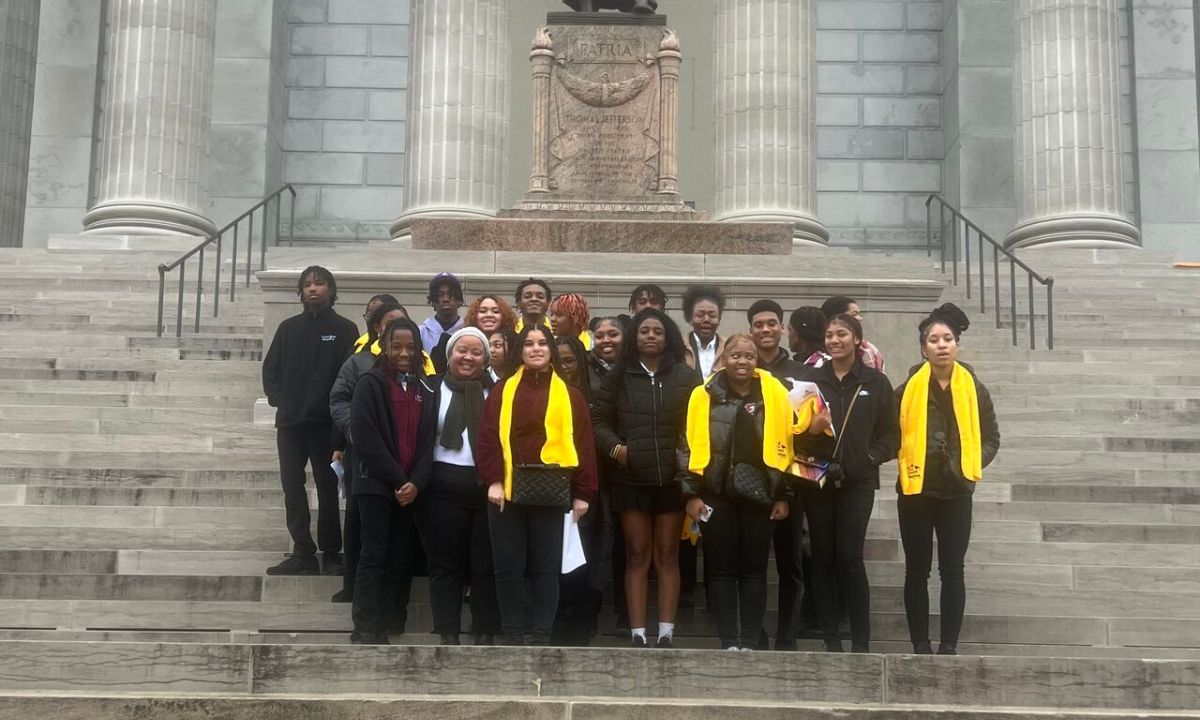In St. Louis, Empowering Missouri Students to Learn the System – And Then Beat It
High school students learn the nuts and bolts how their school district runs, then develop plans to advocate for change.

Get stories like this delivered straight to your inbox. Sign up for The 74 Newsletter
Updated
When 17-year-old Mackayla James sat down this month with three of the 11 candidates vying for open seats on the St. Louis School Board, she wanted to know one thing: How will they take student concerns more seriously and give them more input into the decisions made about their education?
“This is about building a better educational system,” says James, a junior at KIPP High School in St. Louis. “I’m about to graduate next year, but my sister has yet to enter high school, and I don’t want her to be dealing with the same things that I’m dealing with. Adults always say they can make things better for the next generation. Yet the school system is getting worse. It’s not improving. It’s worsening.”
The contentious election, now just three weeks away, comes as the district faces teacher and bus driver shortages, dwindling student enrollment expected to result in school closures, an audit over alleged misuse of district funds by the prior superintendent and chronically low rates of academic achievement.
In many ways, St. Louis is similar to other urban school districts attempting to claw their way back from the devastating impact of the COVID-19 pandemic. In other ways, it’s very different: Child poverty is high – higher, in fact, than 95% of communities nationwide – and crime, though on a downward trajectory, is still high enough that the state may strip the city’s control of its own police force.
James, meanwhile, is one of the St. Louis area high school students selected after a competitive application process to be part of a small cohort that gathers weekly to learn the nuts and bolts of advocacy and how to effectively inject their voices into the political process. The program, Youth Activators, encompasses a handful of semester-long cohorts and summer fellowships operated by Activate Missouri, all of which focus on boosting civic engagement among young people, with the goal of lifting up student voices in under-resourced communities across the state.
Among other things, the program educates students about the ways schools and districts are funded, the reasons funding can be so disparate, the state of education in their communities and how it got to be that way. With help from the organization’s own grassroots leaders, students identify the people in positions of power in their community and build their own advocacy campaigns to advance an issue that’s important to them.
Vera Pantazis, a 17-year-old junior at Maplewood Richmond High School who is also part of the St. Louis cohort, had questions of her own for the school board candidates. Tutoring to improve math and reading scores is well and fine, she said, but show me the fine print.
“So you say that you’re going to provide free tutoring for all kids. What’s that going to look like? How are we funding this? Who’s going to be doing the tutoring, you know? Is that going to be for all schools? All grades? I wanted more details on the biggest education proposals.”
The youth engagement effort marks a change in strategy for the education advocacy group, which had been focusing resources on trying to engage, educate and organize parents on the issues.
“We were asking the people most impacted by the systemic inequalities to fix the issue,” says Tiara Jordan-Sutton, founder and executive director of Activate STL, an offshoot of the statewide organization. “But they have so many things on their plate, and if they have to choose between working another job to put food on the table or attending a curriculum night at their kids school or coming to an organizing meeting, they’re gonna choose to put the food on the table. At the end of the day, there’s multiple competing factors that are keeping parents from being able to jump in this fight. So we needed to think about this from another lens.”
That lens is now trained on students, or as Jordan-Sutton likes to remind folks, “the very people who are closest to the issue.” The issue being, of course, the significant academic and fiscal challenges of the K-12 system. According to the most recent NAEP results, just 27% of fourth-grade students in Missouri and 26% of eighth graders are proficient in reading. In math, 36% of fourth graders and 23% of eighth graders are proficient. No grade-score combination reached pre-pandemic level, and the performance gap between white students and Black students hasn’t budged for more than two decades.
Out of all the districts in Missouri, St. Louis Public Schools posted the third lowest scores on the state’s standardized tests last year, with just 21% of students passing the English Language arts assessment and 17% passing the math assessment. The chronic disinvestment of the system has pushed families out of the city in droves, reducing total enrollment by roughly 20% over the past decade.
“A lot of people in St. Louis think that what’s happening here is the norm,” Jordan-Sutton says. “We have an opportunity to get to them [students] earlier, so that by the time they become parents, they have a very different understanding of why education is the way that it is, who’s allowing it to stay this way, and what the factors or levers are that can be pulled for it to actually improve.”
Activate ATL and the youth advocacy programs she oversees are funded by The Opportunity Trust, a nonprofit organization working to strengthen public education for St. Louis students.
The youth advocacy programs include a paid summer fellowship for high school juniors, seniors and recent graduates, which operates weekdays, 9 a.m. to 4:30 p.m., like a real job, and provides young people with a deep understanding about the myriad issues impacting St. Louis – especially education, but also housing and crime – and the tools needed to effectively organize. Among other things, they’re responsible for drafting get-out-the-vote campaigns focused on education equity.
The semester-long cohorts for high school students run during the school year. Students meet twice a week to learn about how the K-12 system operates and is funded, who controls the purse strings, how the school board operates and who the biggest decision-makers are in the system. They canvas to register students old enough to vote, travel to Jefferson City to meet with legislators at the state capital and draft their own advocacy campaigns related to something they’d like to change at their school. The experience culminates with a pitch contest for a chance to have an advocacy campaign funded and brought to life.
Those pitches include everything from establishing a mental health buddy system among students to increasing the availability of tutoring to becoming more environmentally friendly. For James, who’s biggest concern is lack of communication and understanding of the issues that students face in school, she is considering proposing a plan that would allow a student representative from each high school to sit on the school board.
“We want students to imagine what school could be like,” says Jordan-Sutton, who began her career as a special education teacher and then principal in Chicago. “What are the things that they love about their school, and what do they wish that they had that’s missing? We tell them, ‘You can do something about that. Let me show you how.’”
“We teach them how to organize for change in a very structured way,” she says. “It’s not about just staging a protest, or walking out of school, or going to the principal and saying, ‘I want this,’ and expecting the principal to do it. It’s how to fine tune an idea, research it, think through how it should be implemented and whether anyone has ever tried it before. It’s thinking through how to build coalitions of support for it because there’s strength in numbers and how to survey peers to better understand the nuances of it. And finally, it’s about figuring out who in the power dynamics has the ability to implement the change you’re asking for.”
The pivot to focus on youth advocacy is perhaps the next iteration of the national movement that’s taken shape in the wake of the pandemic, with groups like Ed Navigator and the National Parents Union helping parents become smarter public education consumers and savvier advocates for change. Yet research shows that young people are eager to be involved in the process, but often feel overlooked by the political process and unprepared or unqualified to take action.
According to the Center for Information & Research on Civic Learning and Engagement, young people (18-29) believe that their generation can and should engage in civic life and effect change: 74% said that there are things they can do to make the world a better place, 76% believe that their age group has the power to change things, and 83% recognize the potential of young people working with other generations to create change. However, many don’t feel informed or qualified enough to participate in politics. Only half of youth say they feel they’re “as well-informed as most people,” and even fewer (40%) say that they feel well-qualified to participate in politics.
Moreover, young people from groups that have historically held less political power were even less likely to feel qualified, with 34% of youth of color saying they feel qualified to participate in politics, compared to 44% of white youth.
In addition, a growing body of research shows that when students regard their school leadership as responsive to their expressed input and criticism, students themselves have better grades, attendance and reduced rates of chronic absenteeism. Students who believe they have a voice in school are seven times more likely to be academically motivated than students who do not believe they have a voice, and student voice is also linked to an increased likelihood that students will experience self-worth, engagement, and purpose in school.
“In this moment, with all of these different elections coming up, how do we ensure that the student voice is elevated?” asks Rachel Powers, a senior vice president at The Opportunity Trust. “How do we support students in the same way that we support parents to advocate for what they are looking for, what they need, what they see in their own spaces, in their schools, in their communities?
“We’re trying to get students in that ethos and to understand the power of their collective voice,” she adds. “We know that people who go to the polls don’t always look like people who are served in our schools. And that’s something we point out and ask them, who’s making the real decisions about what happens to you, and do you want to be involved in making decisions that impact you and your community?”
This article was published with the support of XQ Institute.
Disclosure: The Opportunity Trust provides financial support to The 74.
Get stories like these delivered straight to your inbox. Sign up for The 74 Newsletter

;)